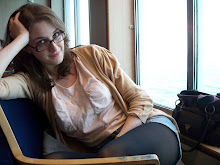Tuesday, 30 November 2010
Sunday, 28 November 2010
Saturday, 27 November 2010
Prints of the Rain Drawings.
To find a way of using the rain drawings in my work, I photocopied them to draw over. The photocopies show the ink darker and thicker than the actual sketches, which I like. The photocopier picks up any dark areas easier than thin or pale lines, which means there is greater contrast between the two. This is most noticeable on the first tree I drew.
Thursday, 25 November 2010
Rain Drawings.
During a tutorial, ideas were discussed about how to move my work on from being so 'controlled'. It was suggested I go outside whilst its raining and draw trees and landscapes there. This was to explore a more natural and unexpected way of producing sketches. I went out with a sketchbook, stencil and fine liner and returned with a couple of quick sketches.
As it gets colder, I plan on drawing whilst it's snowing too; the snowflakes will melt on the page and smudge the ink. However 'snow drawings' could also mean something entirely different. It could be drawing whilst it is snowing, drawing in the snow itself, drawing using snow, leaving a drawing in the snow to be smudged afterwards; there are many possibilities to experiment with.
I like the mess of ink the stencil created, this was from the dry ink already on the stencil coming into contact with the rain. I also prefer the first sketch I did when it was raining a lot harder. This made it quite difficult to draw, and so the image is a lot paler and more smudged than the second tree.
As it gets colder, I plan on drawing whilst it's snowing too; the snowflakes will melt on the page and smudge the ink. However 'snow drawings' could also mean something entirely different. It could be drawing whilst it is snowing, drawing in the snow itself, drawing using snow, leaving a drawing in the snow to be smudged afterwards; there are many possibilities to experiment with.
Saturday, 20 November 2010
Tuesday, 16 November 2010
Sunday, 14 November 2010
Patrick Benson
Patrick Benson illustrated The Minpins by Roald Dahl. A short story for children, The Minpins is about a boy named Little Billy and his exploration of The Forest of Sin.
Benson studied classical drawing in Florence before becoming an illustrator, which seems evident in his drawings. The people he draws are proportionally correct and the landscapes are accurately detailed.
Benson studied classical drawing in Florence before becoming an illustrator, which seems evident in his drawings. The people he draws are proportionally correct and the landscapes are accurately detailed.
I like the detail of the shading in his drawings; short ink lines and scratches provide lively movement to the images which are illuminated by sunshine-dappled leaves and rays of light between the trees; created with effective paint washes.
Saturday, 13 November 2010
Quentin Blake and landscapes.
Quentin Blake has been illustrating for years. Although he studied English at Cambridge, it was drawing and painting which provided him with such a long-standing career. Born in 1932, his first drawings were published when he was only 16; he went on to draw for several magazines and became head of the illustration department at Royal College of Art for 8 years until 1986. However, he is most well known for his illustrations of various children's books, especially his collaboratively work with Roald Dahl. During the 1990s he became involved with exhibition curating in London and Paris, and has also written and illustrated his own books.
The media he uses is simple; a light box, watercolour paper, watercolour paints, waterproof black ink and dip pens. The images I've found for contextual research are of countryside or rural landscapes and trees. My own practise is looking at trees and woodlands, and my preferred choice of materials and media is paper, watercolours and black fine liner pens. Quentin Blake is a very appropriate artist for the contextualisation of my work. His images are more colour and paint orientated than mine and he draws people and figures more often than landscapes. Yet I find his landscapes intriguing; some may argue against their unrealistic characteristics and simplicity but I think the selective amounts of paint and ink and allowing parts of the white paper to show through, creates perfect light in the image.
Friday, 12 November 2010
Subscribe to:
Comments (Atom)


























































